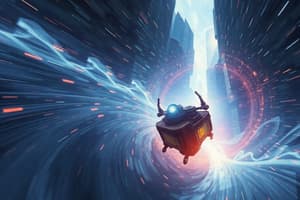Podcast
Questions and Answers
A book rests on a table. Which force prevents the book from moving downwards?
A book rests on a table. Which force prevents the book from moving downwards?
- Gravity
- Sliding friction
- Static friction (correct)
- Fluid friction
An astronaut has a mass of 60 kg on Earth. What would change if they were on the moon?
An astronaut has a mass of 60 kg on Earth. What would change if they were on the moon?
- Their mass and weight would both decrease.
- Their mass would decrease, and their weight would remain the same.
- Their mass would remain the same, and their weight would decrease. (correct)
- Their mass and weight would remain the same.
Which of the following is an example of a non-contact force?
Which of the following is an example of a non-contact force?
- Gravity acting on a falling apple (correct)
- Pushing a box across the floor
- A car experiencing air resistance
- Friction between two surfaces
As the distance between two objects increases, what happens to the gravitational force between them?
As the distance between two objects increases, what happens to the gravitational force between them?
A car is traveling at a constant velocity. What can be said about the forces acting upon the car?
A car is traveling at a constant velocity. What can be said about the forces acting upon the car?
Which type of friction is typically greater: static friction or sliding friction?
Which type of friction is typically greater: static friction or sliding friction?
Which factor does NOT affect the force of friction between two surfaces?
Which factor does NOT affect the force of friction between two surfaces?
A skydiver opens their parachute. What type of friction becomes most significant?
A skydiver opens their parachute. What type of friction becomes most significant?
Two objects have masses $m_1$ and $m_2$, and are separated by a distance $r$. If the mass of each object is doubled, what happens to the gravitational force between them?
Two objects have masses $m_1$ and $m_2$, and are separated by a distance $r$. If the mass of each object is doubled, what happens to the gravitational force between them?
Why is weight measured in Newtons?
Why is weight measured in Newtons?
Flashcards
Force
Force
A push or pull on an object measured in newtons (N).
Contact Force
Contact Force
A push or pull on one object by another that is touching it.
Non-contact Force
Non-contact Force
A push or pull on one object without touching it.
Friction
Friction
Signup and view all the flashcards
Static Friction
Static Friction
Signup and view all the flashcards
Sliding Friction
Sliding Friction
Signup and view all the flashcards
Fluid Friction
Fluid Friction
Signup and view all the flashcards
Gravity
Gravity
Signup and view all the flashcards
Mass
Mass
Signup and view all the flashcards
Weight
Weight
Signup and view all the flashcards
Study Notes
- Forces and motion: How forces change the motion of an object
Gravity and Friction
- Contact forces and non-contact forces
- Law of universal gravitation
- How friction affects the motion of two objects sliding past each other
Types of Forces
- Force: A push or a pull on an object
- Forces are measured in newtons (N)
- Contact force: A push or pull on one object by another that is touching it
- Example: Pushing a container, pressing on computer keys, and friction
- Non-contact force: A push or pull on one object without touching it
- Example: Gravity, magnetic, and electrical
Types of Friction
- Friction resists the motion of two objects that are touching
- Static friction prevents objects from sliding past each other
- Sliding friction opposes the motion of objects sliding past each other
- Fluid friction occurs between a surface and a fluid, such as water or air (air resistance)
Static Friction vs Sliding Friction
- Static friction: Static friction of -100N + 100N of applied force results in Net Force = 0N
- Sliding friction: Sliding friction of -70N + 200N of applied force results in Net Force = ?
Gravity Affected by Mass and Distance
- Gravity is an attractive force between all objects with mass
- Mass is the amount of matter in an object
- Change in mass: The more the mass, the more gravitational pull
- Change in distance affects gravitational pull
- The greater the distance, the less gravitational pull
Weight vs. Mass
- Weight: The amount of gravitational force exerted on an object
- Weight is measured in newtons (n)
- Scenario: An astronaut weighs 539N and has a mass of 55kg on Earth
- On the moon, her weight would be less
- If her mass changed, it would mean that she got thinner or fatter
Non-contact Force: Electrical
- Static Charge: Unbalanced positive or negative charge on an object
- Opposite charges attract each other
- The same charges repel each other
- Variables that affect electric charge:
- Amount of charge: Increased charge results in greater electrical force (attraction or repulsion)
- Increased distance results in less electrical force
Non-contact Force: Magnetic
- Magnet: An object that attracts metal iron
- Magnetic Pole: The location on a magnet where the force applied is the strongest
- Opposite poles (charges) attract each other
- The same poles (charges) repel each other
- Variables that affect magnetic strength:
- Size of the magnet
- Distance: Increased distance results in weaker magnetic force
Studying That Suits You
Use AI to generate personalized quizzes and flashcards to suit your learning preferences.




